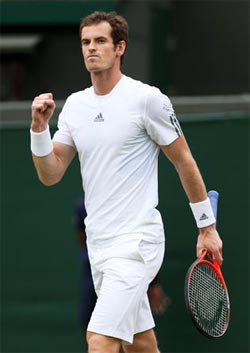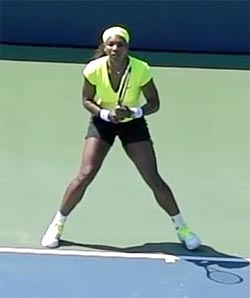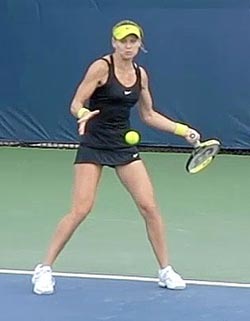|
TennisOne Lessons Who Will Win Wimbledon? Paul Fein “What we anticipate seldom occurs; what we least expected generally happens.” — Benjamin Disraeli The Big Four are no more. Roger Federer hasn’t won a major title since 2012. Rafael Nadal, the long-reigning King of Clay, was rudely dethroned by Novak Djokovic at the French Open, and Nadal’s ranking plummeted to No. 10. Andy Murray hasn’t won a major since 2013 and rarely beats the rest of the Big 4. That leaves Djokovic, French Open champion Stan Wawrinka, a few other plausible contenders, and lots of intriguing questions. Will Stan be the Man at Wimbledon and Grab His Second Straight Major? If Wawrinka can whack 60 winners on slow clay against the sport’s best defender, Novak Djokovic (sorry, Rafa), in the French Open final, then fast grass should prove even more fertile ground for his power shots. That’s true in theory, but it hasn’t been in practice so far. The rugged Swiss has a dismal 13-10 career record at the Big W, though he did make the quarters last year. His serve return, a crucial shot on grass, is seldom offensive, and his long backhand backswing can be a liability on unpredictable grass.
Even so, Wawrinka has momentum and will be seeded No. 4, so he should advance to at least the semis. Don’t listen to Wawrinka when he modestly says, “I’m not as good as the Big Four, though I’m good enough to win two Grand Slam tournaments.” Listen to him when, after beating Jo-Wilfried Tsonga in the French Open semis, he confidently declared, “When I play my best, I know I can beat any player.” Wawrinka has captured two of the last six majors and now belongs in the new Big Four. Does the Legendary Federer Have Another Major Title in Him? He came oh so close last year, losing 6-4 in the fifth set to Djokovic in the Wimbledon final. But Father Time eventually takes a toll on all athletes, even on the seemingly ageless Swiss who turns 34 on August 8. Federer was crushed by eventual champion Marin Cilic in the 2014 US Open semis, upset by No. 46 Andreas Seppi at the Australian Open, and overpowered by Wawrinka at the French Open. His serve has lost some of its sting, his backhand is more vulnerable than ever, and his serve return, particularly in the ad court, is a liability. Keep an eye on a key statistic: break points converted. Federer went 0 for 4 against Wawrinka at Roland Garros, and he often fails on these crucial points in big matches. The seven-time champion ranks a misleading No. 2 in the world, but opponents no longer fear him. He could be upset in the first week. Could the Steadily Rebounding Murray Repeat His 2013 Wimbledon Tour De Force?
Andy has never exuded confidence, but this year he has some reasons for being confident. He’s recovered from back problems and played quite well on clay, winning two tournaments and making the French final on his worst surface. He recruited former world No. 4 Jonas Bjorkman as coach while his current coach, Amelie Mauresmo, nears the end of her pregnancy. Bjorkman’s upbeat personality should energize the reserved Brit, while his aggressive serve-volley style could brush off on the sometimes overly cautious Murray. Highly partisan British spectators—“Murray Mania”—could also propel him at crisis points or help reverse momentum when he falters. On the other hand, Murray’s petulant shouting at his player’s box and berating himself can hurt his play. “Murray is honest, but in a negative way,” three-time Wimbledon champion Boris Becker told the Daily Mail (UK). “I’ve never seen a guy—not even John McEnroe—who commentates on every single point the way Murray does. It’s mind-boggling how much he speaks to himself during the match.” Murray captured the Wimbledon title in 2013 and has advanced to the quarterfinals or better in his last seven appearances. On the debit side, he’s saddled with a horrendous 1-13 record against the Big 4 since January 2014. Djokovic has been his Waterloo, defeating Murray in their last eight matches. It’s doubtful he can dethrone the reigning Wimbledon champion who’s stronger both mentally and physically. But Murray is a surefire semifinalist and possible finalist. Will Nadal Find Greener Pastures on Grass? This is the toughest question. After suffering his worst clay-court season since 2004, Rafa remains mired in his worst career slump. He’s captured only two of his 14 Grand Slam titles at Wimbledon, and they came way back in 2008 and 2010. In his last three appearances, he’s lost in the fourth, first, and second rounds.
Injuries have taken a heavy toll on his 29-year-old physique, and many observers wonder whether the 14-time Grand Slam winner will ever capture another major. Like Djokovic and Murray, much depends on how often and how well he attacks. For Nadal to reach the final and perhaps even win the Big W, he’ll have to regain his once-awesome forehand, hit deep and solid backhands, serve well, and position himself close to the baseline. That’s a tall order, but he’s off to a good grass-season start by winning the Mercedes Cup in Stuttgart. Never count out this all-time great and ultimate warrior! Will Djokovic Rebound From His Deflating Upset Loss to Wawrinka in The French Final? The setback deprived him of a career Grand Slam and a potential Grand Slam this year. Still, his consistency at an elite level is extraordinary: the 28-year-old Serb has reached 14 finals in the last 19 Grand Slam events. Unfortunately, he’s won just seven of them. Why? Too often Djoker hasn’t produced his A game in finals and instead has settled for being a rock-solid, Agassi-like grinder with marvelous defense. That’s not good enough anymore. At Wimbledon, the “A” must stand for “athletic” and “attacking.” Both attributes are crucial on grass. His 2014 Wimbledon triumph revitalized his career after he had lost four of his previous five major finals. After being upset by Wawrinka in the Roland Garros final, Djokovic said, “Pressure is part of what I do. I got used to it. I had many tough matches in my life. Today I went out onto the court knowing I’m close, but across the net I also had a player who wanted to win and had not much to lose. And he was playing very well, and he deserved to win.” Djokovic has bounced back from heart-breaking defeat before. Like a true champion, he’ll do it again and win his third Wimbledon crown. Who are the Other Contenders and Pretenders? The most obvious are 2014 Wimbledon semifinalists Milos Raonic and Grigor Dimitrov. Raonic, a rocket-serving Canadian ranked No. 8, was sidelined for six weeks following foot surgery and may not be match-tough. On the plus side, he dropped 12 pounds and improved his groundstrokes. The immensely talented Dimitrov has beaten Wawrinka twice this year, but otherwise compiled a mediocre 19-12 record. Neither will likely reach the semis. No. 6-ranked Tomas Berdych, the 2010 Wimbledon finalist, has performed much more consistently, reaching three finals, four semifinals (including the Australian Open and Miami Open), and two quarterfinals. He is a potential semifinalist if the draw keeps him away from Djokovic who’s beaten him 19 times in 21 matches. Kei Nishikori, ranked No. 5, will win a major this decade, but it won’t be on Wimbledon grass where his 5’10”, 163-pound physique and lack of serving power hurt him the most. Kevin Anderson, a 6’8” veteran who ranks No. 17 and has beaten Wawrinka four straight times, including recently at the Aegon Championships, is also dangerous grass-court player when he rains down aces and wins tiebreakers. And let’s not forget 6’6” Cilic, a quarterfinalist last year and another big banger who can get hot at any time. Which Dark Horses Can Do Some Damage? Australia hasn’t produced a men’s Grand Slam champion since lightweight but fiercely competitive Lleyton Hewitt took the Wimbledon title in 2002. It now boasts two young and ascending heavyweights in the flamboyant Nick Kyrgios, 20, and poised Thanasi Kokkinakis, 19. If Kyrgios, a surprise quarterfinalist after upsetting Nadal in his 2014 Wimbledon debut, is not hampered by a sore elbow, he could achieve even more this year. But no prospect is more unpredictable. “The concern with Kyrgios is that he appreciates being a showman more than he appreciates being a champion,” said former No. 1 Jim Courier. “His talent is unquestioned. His commitment has been intermittent.” Jiri Vesely, a 6’6”, 198-pound, left-handed Czech 21-year-old has notched 11 wins over top 100 players this year and looks ready for a breakthrough at a major. Jack Sock, a bulky 6’3” American, boasts 10 victories over top 50 opponents this season. He made the French Open fourth round and could go even farther on Wimbledon grass where his serve and forehand power will be fully rewarded. Can Anyone Stop Rampaging Serena Williams? After Serena seized her record eighth Miami title in March, she justifiably declared, “I’d like to believe the older I get, the better I get.” Can (or would) any 33-year-old athlete in any dynamic sport—much less a sport so dependent on the youthful assets of speed, strength, and stamina—make such a statement?
Like Michael Jordan in basketball, Muhammad Ali in boxing, and Jim Brown in football, Serena transformed her sport with a unique combination of mind-blowing athleticism, manifold skills, and a ferocious will to win. These superstars were also perfectionists, a trait that motivates Serena to keep getting better. Since Serena turned 30, she has amazingly won seven of 14 Grand Slam tournaments, including the last three. Only Steffi Graf with 22 majors and Margaret Court with 24 amassed more. If Serena wins both Wimbledon and the US Open, she’ll tie Graf. Even more important and exciting, she’ll pull off a rare feat—the Grand Slam. The last Grand Slammer, male or female, to capture all four majors in a calendar year was Graf in 1988. “She’s a unique athlete. In my opinion she possesses shots and weapons unique in the history of the game,” Graf, told L’Équipe, adding that if anyone can capture the Grand Slam, Serena can. Who can argue with that? Although Serena suffered a bad third-round loss to Alize Cornet a year ago at Wimbledon, she’s hauled in six titles there, four of them in the past six years. Serena is also a “momentum player” both in tournaments and during seasons, and she’s racked up a near-perfect 32-1 record this season. Her booming serve, which peaked at 126 mph at Roland Garros, has made the difference in close matches, such as her five three-set battles in Paris. It will be an even bigger factor at Wimbledon. Serena confided in Vogue magazine, “It’s hard and lonely at the top. … Everyone wants to beat you. Everyone talks behind your back, and you get a lot more criticism. God forbid I lose. It’s like ‘Why?’ Well, I am human.” That she is. But at this Wimbledon, she’ll once again play like Superwoman and crush all challengers. What Can We Expect from Unpredictable Petra Kvitova?
When Kvitova is good, she’s extremely good. The 6’ tower of power broke through in 2011 with a spectacular 6-3, 6-4 upset over Maria Sharapova in the Wimbledon final. Kvitova grabbed five other titles that year, including the WTA Finals, and finished No. 2. The Czech lefty was even more awesome at the 2014 Wimbledon where she annihilated Eugenie Bouchard 6-3, 6-0 in the final. Although Kvitova was upset by another explosive hitter, Madison Keys, at the Australian Open and cagey Swiss Timea Bacsinszky at Roland Garros, she won tournaments at Sydney and Madrid to rank No. 2. Even more important, she achieved something no other woman has this season. In the Madrid semis, she fired her heavy artillery at Serena and destroyed her 6-2, 6-3. Serena and Kvitova, if she reproduces her 2011 and 2014 form, should produce a blockbuster final. Will Maria Sharapova Regain Her Grass-Court Mojo? Who can forget Sharapova’s sensational 2004 Wimbledon title as a rail-thin 17-year-old? In one of the century’s biggest upsets, the precocious Russian knocked off No. 1 Serena 6-1, 6-4 in the final. In a career filled with surprising twists, Sharapova lost all 15 matches to Serena since then and reached only one more Wimbledon final, but has flourished on slow clay, winning two French Opens. Even so, Sharapova owns plenty of grass-court weapons—a powerful first serve and above-average second serve, aggressive serve returns, and “first-strike” power on both her forehand and backhand. She also rates as one of the greatest fighters in the Open Era. She gave Serena a run for her money in the second set of their 6-3, 7-6 Australian final and captured Rome. Hampered by a cold at Roland Garros, she was toppled by Lucie Safarova. Sharapova should bounce back strongly at Wimbledon, though winning it would likely require her to beat her bete noire. How Far Has Victoria Azarenka Come Back? Don’t be misled by two-time Australian Open champion Azarenka’s No. 23 ranking. A left-foot injury limited the 25-year-old Belarusian, and former No. 1, to just nine tournaments last year. She’s gradually returning to her peak 2012−2013 form and is only of the few players who can regularly challenge Serena, even though her career record against Serena is a lopsided 3-16. In Madrid, she had Serena on the ropes before double-faulting the match away and succumbing 7-6, 3-6, 7-6, while at the French Open she led 6-3, 4-2 before going down 3-6, 6-4, 6-2. Though the two-time Wimbledon semifinalist performs best on hard courts, she possesses a burning desire to win more majors and rejoin the sport’s elite. Her low seeding hurts her chances, but she’s still a probable quarterfinalist. Is Late-Blooming Lucie Safarova a Bona-Fide Contender?
No doubt about it. It took lefty Lucie nearly a decade to find her stride at the majors—she advanced past the third round only twice from 2005 to 2013—but last year she gained the Wimbledon semis and the fourth round in Paris and New York. She nearly won the French Open this year, leading the incomparable Serena 2-0 in the third set of the final before bowing. The slender 5’10”, 28-year-old Czech now ranks a career-high No. 6 and abounds with confidence and momentum. Her game is ideal for slick, tricky grass: a swerving slice serve, the ability to slide and glide, and sharply struck groundstrokes from close to the baseline. Her doubles prowess—she and Bethanie Mattek-Sands have won the first two doubles majors this year—attests to her topnotch athleticism and volleying. With a kind draw, she could make it to the semis or even the final. Who Are The Best Of The Rest? Only two of the top eight French Open seeds reached the quarterfinals—Serena and Ana Ivanovic—and you can expect lots of seeds being uprooted at Wimbledon, too. No. 3 Simona Halep, a semifinalist last year, No. 5 Caroline Wozniacki, No. 8 Ekaterina Makarova, No. 9 Carla Suarez Navarro, and No. 10 Angelique Kerber, all counter-punchers without big serves, will likely be upset by hard-hitting, young comers. My foremost pick to click is 6’1” Czech Karolina Pliskova who packs the heaviest punch. As of May 25, Pliskova led the WTA Tour in aces (262) and ranked third in first-serve points won percentage (72.3%), and fifth in service games won percentage (77%) and break points saved percentage (62.8%). She has yet to harness her huge serve and groundstrokes at the majors, but she’s climbed steadily to No. 11. At Wimbledon, Pliskova will break through with a bang and reach at least the quarters. No contender yet to win a major savors grass more than No. 18 Sabine Lisicki. In her last five Wimbledon appearances, the sturdy, 5’10” German reached the 2013 final, a semifinal, and three quarterfinals. Lisicki’s calling card is her explosive serve, and she holds two remarkable records: the fastest serve at 131 mph and the most aces in a match, 27, which she whacked in only 10 service games against Belinda Bencic at the Aegon Classic on June 17.
Camila Giorgi, whose 5’6”, 119-pound frame belies her tremendous power, demonstrated her grass-court skills by winning the ‘S-Hertogenbosch event in the Netherlands. Bencic, a talented 18-year Swiss with stylish strokes, knocked off Kerber and Jelena Jankovic to reach the 2014 US Open quarters, and she’s due for another impressive run at a major. Madison Keys, a fearless slugger much like Pliskova, played brilliantly at the Australian Open, beating Kvitova and Venus Williams to gain the semis. The 20-year-old American’s favorite surface is grass, and this year she’ll show why by reaching at least the quarters. The New World Order in women’s tennis is not here yet, but this Wimbledon will provide lots of clues about who will succeed Queen Serena. * * * * * Your comments are welcome. Let us know what you think about Paul Fein's article by emailing us here at TennisOne.
Paul Fein Paul Fein has received more than 30 writing awards and authored three books, Tennis Confidential: Today’s Greatest Players, Matches, and Controversies, You Can Quote Me on That: Greatest Tennis Quips, Insights, and Zingers, and Tennis Confidential II: More of Today’s Greatest Players, Matches, and Controversies. Fein is also a USPTA-certified teaching pro and coach with a Pro-1 rating, former director of the Springfield (Mass.) Satellite Tournament, a former top 10-ranked men’s open New England tournament player, and currently a No. 1-ranked Super Senior player in New England. |


